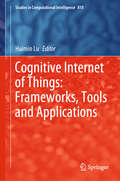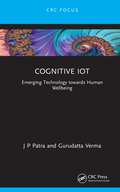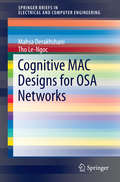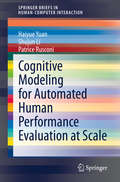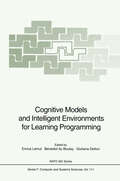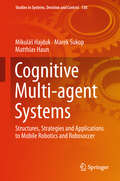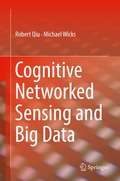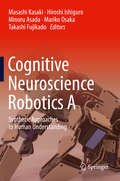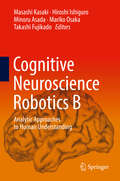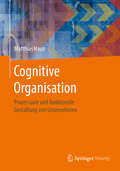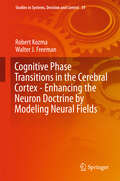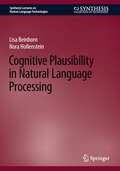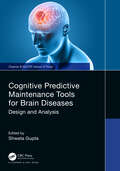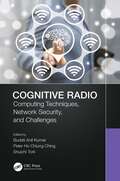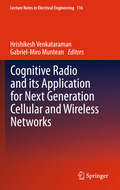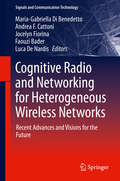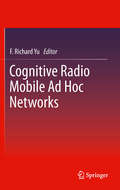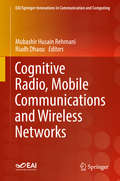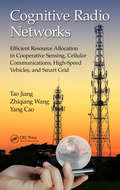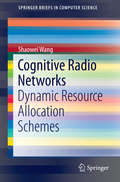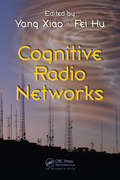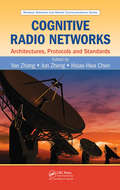- Table View
- List View
Cognitive Internet of Things: Frameworks, Tools and Applications (Studies in Computational Intelligence #810)
by Huimin LuThis book provides insights into the research in the fields of artificial intelligence in combination with Internet of Things (IoT) technologies. Today, the integration of artificial intelligence and IoT technologies is attracting considerable interest from both researchers and developers from academic fields and industries around the globe. It is foreseeable that the next generation of IoT research will focus on artificial intelligence/beyond artificial intelligence approaches. The rapidly growing numbers of artificial intelligence algorithms and big data solutions have significantly increased the number of potential applications for IoT technologies, but they have also created new challenges for the artificial intelligence community. This book shares the latest scientific advances in this area.
Cognitive IoT: Emerging Technology towards Human Wellbeing (Intelligent Signal Processing and Data Analysis)
by J P Patra Gurudatta VermaThis book deals with a different research area of cognitive IoT and explains how machine learning algorithms can be applied for cognitive IoT. It deals with applications of cognitive IoT in this pandemic (COVID-19), applications for student performance evaluation, applications for human healthcare for chronic disease prediction, use of wearable sensors and review regarding their energy optimization and how cognitive IoT helps in farming through rainfall prediction and prediction of lake levels. Features: Describes how cognitive IoT is helpful for chronic disease prediction and processing of data gathered from healthcare devices Explains different sensors available for health monitoring Explores application of cognitive IoT in COVID-19 analysis Discusses pertinent and efficient farming applications for sustaining agricultural growth Reviews smart educational aspects such as student response, performance, and behavior and instructor response, performance, and behavior This book aims at researchers, professionals and graduate students in Computer Science and Engineering, Computer Applications and Electronics Engineering, and Wireless Communications and Networking.
Cognitive IoT: Emerging Technology towards Human Wellbeing (Intelligent Signal Processing and Data Analysis)
by J P Patra Gurudatta VermaThis book deals with a different research area of cognitive IoT and explains how machine learning algorithms can be applied for cognitive IoT. It deals with applications of cognitive IoT in this pandemic (COVID-19), applications for student performance evaluation, applications for human healthcare for chronic disease prediction, use of wearable sensors and review regarding their energy optimization and how cognitive IoT helps in farming through rainfall prediction and prediction of lake levels. Features: Describes how cognitive IoT is helpful for chronic disease prediction and processing of data gathered from healthcare devices. Explains different sensors available for health monitoring. Explores application of cognitive IoT in COVID-19 analysis. Discusses pertinent and efficient farming applications for sustaining agricultural growth. Reviews smart educational aspects such as student response, performance, and behavior and instructor response, performance, and behavior. This book aims at researchers, professionals and graduate students in Computer Science and Engineering, Computer Applications and Electronics Engineering, and Wireless Communications and Networking.
Cognitive MAC Designs for OSA Networks (SpringerBriefs in Electrical and Computer Engineering)
by Mahsa Derakhshani Tho Le-NgocThis SpringerBrief presents recent advances in the cognitive MAC designs for opportunistic spectrum access (OSA) networks. It covers the basic MAC functionalities and MAC enhancements of IEEE 802.11. Later chapters discuss the existing MAC protocols for OSA and classify them based on characteristic features.The authors provide new research in adaptive carrier sensing-based MAC designs tailored for OSA, which optimize spectrum utilization and ensure a peaceful coexistence of licensed and unlicensed systems. Analytically devised via optimization and game-theoretic approaches, these adaptive MAC designs are shown to effectively reduce collisions between both primary and secondary network users.Researchers and professionals working in wireless communications and networks will find this content valuable. This brief is also a useful study guide for advanced-level students in computer science and electrical engineering.
Cognitive Modeling for Automated Human Performance Evaluation at Scale (Human–Computer Interaction Series)
by Haiyue Yuan Shujun Li Patrice RusconiCognitive models and software tools have been widely used for both research and commercial purposes. Although they have proved very useful, there are some limitations preventing large-scale modeling and simulation tasks to be carried out efficiently and effectively. In this book, we aim to provide readers with a systematic overview of state-of-the-art cognitive modeling software tools and applications and an introduction to a new software framework for facilitating large-scale modeling and simulation of human-performance tasks. The authors first review cognitive modeling theories and then present an overview of state-of-the-art software tools for cognitive modeling and simulation. Finally, the book focuses on the new software framework and a research prototype called CogTool+, including how to incorporate behavioral data such as eye-tracking data in modeling and simulation tasks. Typical applications of CogTool+ in HCI and cyber security are given to demonstrate its usefulness.
Cognitive Models and Intelligent Environments for Learning Programming (NATO ASI Subseries F: #111)
by Enrica Lemut Benedict Du Boulay Giuliana DettoriAt present, there is a general consensus on the nature of learning programming, but there are different opinions on what forms an effective environment for it. It is generally recognized that the development of a mental model is a formidable task for the student and that learning programming is a complex activity that depends heavily on metacognitive skills. This book, based on a NATO workshop, presents both pure cognitive models and experimental learning environments, and discusses what characteristics can make a learning model effective, especially in relation to the learning environment (natural or computerized). The papers cover cognitive models related to different aspects of programming, classes of learners, and types of environment, and are organized in three groups: theoretical and empirical studies on understanding programming, environments for learning programming, and learning programming in school environments. Comprehension, design, construction, testing, debugging, and verification are recognized as interdependent skills, which require complicated analysis and may develop independently, and indifferent orders, in novices. This book shows that there is unlikely to be asingle path from novice to expert and that the structure of the final product (the program) may not constrain the process by which it comes into being as much as some would advocate.
Cognitive Multi-agent Systems: Structures, Strategies and Applications to Mobile Robotics and Robosoccer (Studies in Systems, Decision and Control #138)
by Mikuláš Hajduk Marek Sukop Matthias HaunThe book describes an approach to the multi-agent systems (MAS) design for applications of robotic soccer in the MiroSot category. The described MAS is designed for dynamic, quickly changing environments, in which not only the actions of our MAS are observed, but also those of the opposing MAS. It actively tries to affect the environment to score goals faster than the opposing MAS. Multi-agent systems (MAS) are mostly applied in the environments in which they exist and act without an opposing system. The book also describes strategies based on a supervisor that makes decisions depending on behavior prediction of the opposing MAS and the ball movement in the working place. A sophisticated distribution of tasks was designed for each agent to cooperate in order score goals as fast as possible. Simultaneously, these agents try, by permitted means, to prevent the enemy agents from scoring goals. The approach described is an excellent guide to the constantly evolving abilities of mobile robotics, both for real-world applications, such as cooperation of multiple robots in life-saving activities, and for the steadily developing applications of mobile robots in various robotic competitions (e.g. Robocup, etc.). The book provides readers with high-level knowledge on how to design strategies and how to implement such systems, and the ideas presented enable them to further refine the approach utilizing the latest hardware and use it in new systems implementations of sophisticated intelligent engineering.
Cognitive Networked Sensing and Big Data
by Robert Qiu Michael WicksWireless Distributed Computing and Cognitive Sensing defines high-dimensional data processing in the context of wireless distributed computing and cognitive sensing. This book presents the challenges that are unique to this area such as synchronization caused by the high mobility of the nodes. The author will discuss the integration of software defined radio implementation and testbed development. The book will also bridge new research results and contextual reviews. Also the author provides an examination of large cognitive radio network; hardware testbed; distributed sensing; and distributed computing.
Cognitive Neuroscience Robotics A: Synthetic Approaches to Human Understanding
by Masashi Kasaki Hiroshi Ishiguro Minoru Asada Mariko Osaka Takashi FujikadoCognitive Neuroscience Robotics is the first introductory book on this new interdisciplinary area. This book consists of two volumes, the first of which, Synthetic Approaches to Human Understanding, advances human understanding from a robotics or engineering point of view. The second, Analytic Approaches to Human Understanding, addresses related subjects in cognitive science and neuroscience. These two volumes are intended to complement each other in order to more comprehensively investigate human cognitive functions, to develop human-friendly information and robot technology (IRT) systems, and to understand what kind of beings we humans are. Volume A describes how human cognitive functions can be replicated in artificial systems such as robots, and investigates how artificial systems could acquire intelligent behaviors through interaction with others and their environment.
Cognitive Neuroscience Robotics B: Analytic Approaches to Human Understanding
by Masashi Kasaki Hiroshi Ishiguro Minoru Asada Mariko Osaka Takashi FujikadoCognitive Neuroscience Robotics is the first introductory book on this new interdisciplinary area. This book consists of two volumes, the first of which, Synthetic Approaches to Human Understanding, advances human understanding from a robotics or engineering point of view. The second, Analytic Approaches to Human Understanding, addresses related subjects in cognitive science and neuroscience. These two volumes are intended to complement each other in order to more comprehensively investigate human cognitive functions, to develop human-friendly information and robot technology (IRT) systems, and to understand what kind of beings we humans are. Volume B describes to what extent cognitive science and neuroscience have revealed the underlying mechanism of human cognition, and investigates how development of neural engineering and advances in other disciplines could lead to deep understanding of human cognition.
Cognitive Organisation: Prozessuale und funktionale Gestaltung von Unternehmen
by Matthias HaunDie in dem Buch beschriebenen Methoden und Techniken sichern Unternehmen den Entwicklungsvorsprung, der benötigt wird, um mit hoher Innovations- und Zukunftssicherheit in organisatorischer und technologischer Hinsicht auf dynamischen Märkten zu bestehen.Der innovative Ansatz stellt die Begriffe Kognition, Organisation, Wissen und Technologie in den Mittelpunkt. Mit Hilfe der wissensbasierten, handlungsorientierten und simulationsvalidierten Methodik können innovative Unternehmen als kognitive, wandelbare Organisationen entwickelt werden.
Cognitive Phase Transitions in the Cerebral Cortex - Enhancing the Neuron Doctrine by Modeling Neural Fields (Studies in Systems, Decision and Control #39)
by Robert Kozma Walter J. FreemanThis intriguing book was born out of the many discussions the authors had in the past 10 years about the role of scale-free structure and dynamics in producing intelligent behavior in brains. The microscopic dynamics of neural networks is well described by the prevailing paradigm based in a narrow interpretation of the neuron doctrine. This book broadens the doctrine by incorporating the dynamics of neural fields, as first revealed by modeling with differential equations (K-sets). The book broadens that approach by application of random graph theory (neuropercolation). The book concludes with diverse commentaries that exemplify the wide range of mathematical/conceptual approaches to neural fields. This book is intended for researchers, postdocs, and graduate students, who see the limitations of network theory and seek a beachhead from which to embark on mesoscopic and macroscopic neurodynamics.
Cognitive Plausibility in Natural Language Processing (Synthesis Lectures on Human Language Technologies)
by Lisa Beinborn Nora HollensteinThis book explores the cognitive plausibility of computational language models and why it’s an important factor in their development and evaluation. The authors present the idea that more can be learned about cognitive plausibility of computational language models by linking signals of cognitive processing load in humans to interpretability methods that allow for exploration of the hidden mechanisms of neural models. The book identifies limitations when applying the existing methodology for representational analyses to contextualized settings and critiques the current emphasis on form over more grounded approaches to modeling language. The authors discuss how novel techniques for transfer and curriculum learning could lead to cognitively more plausible generalization capabilities in models. The book also highlights the importance of instance-level evaluation and includes thorough discussion of the ethical considerations that may arise throughout the various stages of cognitive plausibility research.
Cognitive Predictive Maintenance Tools for Brain Diseases: Design and Analysis (Chapman & Hall/CRC Internet of Things)
by Shweta GuptaThis book involves the design, analysis, and application of various cognitive predictive maintenance tests with the help of tools like vibration analysis, ultrasonic analysis, infrared analysis, oil analysis, laser-shaft alignment, and motor circuit analysis in the prediction of various cognitive diseases such as epilepsy, Parkinson’s disease, Alzheimer’s disease, and depression. These are needed since there are no proper medical tests available to predict these diseases in remote areas at an early stage. Various emerging technologies are analyzed for the design of tests. Key features: Incorporates innovative processes for treating cognitive diseases. Early and exact identification and treatment strategies are incorporated. Future technologies like artificial intelligence, machine learning, the IoT, and data science are used to find solutions. Analysis with existing cognitive disease solutions is incorporated and simulations provided. The novelty of the book lies in the accurate prediction of cognitive diseases. Encompassing future technologies and various communication protocols or devices available for cognitive diseases for the design of new equipment are an outcome of the book. Various parameters like power consumption, productivity, and safety should be taken into account during the analysis, design, and application of a product. The book could well be added to the curriculum of medical colleges and biomedical engineering students. Possible vendors include biomedical research centers like Biotechnika and the Indian Council of Medical Research (ICMR). It would be a breakthrough for biomedical companies to launch their new products.
Cognitive Predictive Maintenance Tools for Brain Diseases: Design and Analysis (Chapman & Hall/CRC Internet of Things)
This book involves the design, analysis, and application of various cognitive predictive maintenance tests with the help of tools like vibration analysis, ultrasonic analysis, infrared analysis, oil analysis, laser-shaft alignment, and motor circuit analysis in the prediction of various cognitive diseases such as epilepsy, Parkinson’s disease, Alzheimer’s disease, and depression. These are needed since there are no proper medical tests available to predict these diseases in remote areas at an early stage. Various emerging technologies are analyzed for the design of tests. Key features: Incorporates innovative processes for treating cognitive diseases. Early and exact identification and treatment strategies are incorporated. Future technologies like artificial intelligence, machine learning, the IoT, and data science are used to find solutions. Analysis with existing cognitive disease solutions is incorporated and simulations provided. The novelty of the book lies in the accurate prediction of cognitive diseases. Encompassing future technologies and various communication protocols or devices available for cognitive diseases for the design of new equipment are an outcome of the book. Various parameters like power consumption, productivity, and safety should be taken into account during the analysis, design, and application of a product. The book could well be added to the curriculum of medical colleges and biomedical engineering students. Possible vendors include biomedical research centers like Biotechnika and the Indian Council of Medical Research (ICMR). It would be a breakthrough for biomedical companies to launch their new products.
Cognitive Radio: Computing Techniques, Network Security and Challenges
by Budati Anil KumarThe scarcity of radio spectrum is one of the most urgent issues at the forefront of future network research that is yet to be addressed. To address the problem of spectrum usage efficiency, the cognitive radio (CR) concept was proposed. The challenges of employing CRs include ensuring secure device operations and data transmission with advanced computing techniques. Successful development of CR systems will involve attainment of the following key objectives: Increasing the rate and capacity of CR-based networks How the power is utilized in CR hardware devices with CMOS circuits How the framework is needed in complex networks Vedic multipliers on CR networks Spatial analysis and clustering methods for traffic management To transmit a large volume of data like video compression Swarm optimization algorithms Resource sharing in peer-to-peer networking This book gathers the latest research works focusing on the issues, challenges, and solutions in the field of Cognitive Radio Networks, with various techniques. The chapters in this book will give solutions to the problems that Industry 4.0 faces, and will be an essential resource for scholars in all areas of the field.
Cognitive Radio: Computing Techniques, Network Security and Challenges
by Budati Anil Kumar Peter Ho Chiung Ching Shuichi ToriiThe scarcity of radio spectrum is one of the most urgent issues at the forefront of future network research that is yet to be addressed. To address the problem of spectrum usage efficiency, the cognitive radio (CR) concept was proposed. The challenges of employing CRs include ensuring secure device operations and data transmission with advanced computing techniques. Successful development of CR systems will involve attainment of the following key objectives: Increasing the rate and capacity of CR-based networks How the power is utilized in CR hardware devices with CMOS circuits How the framework is needed in complex networks Vedic multipliers on CR networks Spatial analysis and clustering methods for traffic management To transmit a large volume of data like video compression Swarm optimization algorithms Resource sharing in peer-to-peer networking This book gathers the latest research works focusing on the issues, challenges, and solutions in the field of Cognitive Radio Networks, with various techniques. The chapters in this book will give solutions to the problems that Industry 4.0 faces, and will be an essential resource for scholars in all areas of the field.
Cognitive Radio and its Application for Next Generation Cellular and Wireless Networks (Lecture Notes in Electrical Engineering #116)
by Hrishikesh Venkataraman and Gabriel-Miro MunteanThis book provides a broad introduction to Cognitive Radio, which attempts to mimic human cognition and reasoning applied to Software Defined Radio and reconfigurable radio over wireless networks. It provides readers with significant technical and practical insights into different aspects of Cognitive Radio, starting from a basic background, the principle behind the technology, the inter-related technologies and application to cellular and vehicular networks, the technical challenges, implementation and future trends. The discussion balances theoretical concepts and practical implementation. Wherever feasible, the different concepts explained are linked to application of the corresponding scheme in a particular wireless standard. This book has two sections: the first section begins with an introduction to cognitive radio and discusses in detail various, inter-dependent technologies such as network coding, software-based radio, dirty RF, etc. and their relation to cognitive radio. The second section deals with two key applications of cognitive radio – next generation cellular networks and vehicular networks. The focus is on the impact and the benefit of having cognitive radio-based mechanisms for radio resource allocation, multihop data transmission, co-operative communication, cross-layer solutions and FPGA-level framework design, as well as the effect of relays as cognitive gateways and real-time, seamless multimedia transmission using cognitive radio.
Cognitive Radio and Networking for Heterogeneous Wireless Networks: Recent Advances and Visions for the Future (Signals and Communication Technology)
by Maria-Gabriella Di Benedetto Andrea F. Cattoni Jocelyn Fiorina Faouzi Bader Luca De NardisThis book, written by leading experts from academia and industry, offers a condensed overview on hot topics among the Cognitive Radios and Networks scientific and industrial communities (including those considered within the framework of the European COST Action IC0902) and presents exciting visions for the future. Examples of the subjects considered include the design of new filter bank-based air interfaces for spectrum sharing, medium access control design protocols, the design of cloud-based radio access networks, an evolutionary vision for the development and deployment of cognitive TCP/IP, and regulations relevant to the development of a spectrum sharing market. The concluding chapter comprises a practical, hands-on tutorial for those interested in developing their own research test beds. By focusing on the most recent advances and future avenues, this book will assist researchers in understanding the current issues and solutions in Cognitive Radios and Networks designs.
Cognitive Radio Mobile Ad Hoc Networks
by F. Richard YuCognitive radios (CR) technology is capable of sensing its surrounding environment and adapting its internal states by making corresponding changes in certain operating parameters. CR is envisaged to solve the problems of the limited available spectrum and the inefficiency in the spectrum usage. CR has been considered in mobile ad hoc networks (MANETs), which enable wireless devices to dynamically establish networks without necessarily using a fixed infrastructure. The changing spectrum environment and the importance of protecting the transmission of the licensed users of the spectrum mainly differentiate classical MANETs from CR-MANETs. The cognitive capability and re-configurability of CR-MANETs have opened up several areas of research which have been explored extensively and continue to attract research and development. The book will describe CR-MANETs concepts, intrinsic properties and research challenges of CR-MANETs. Distributed spectrum management functionalities, such as spectrum sensing and sharing, will be presented. The design, optimization and performance evaluation of security issues and upper layers in CR-MANETs, such as transport and application layers, will be investigated.
Cognitive Radio, Mobile Communications and Wireless Networks (EAI/Springer Innovations in Communication and Computing)
by Mubashir Husain Rehmani Riadh DhaouThis book provides an overview of the latest research and development of new technologies for cognitive radio, mobile communications, and wireless networks. The contributors discuss the research and requirement analysis and initial standardization work towards 5G cellular systems and the capacity problems it presents. They show how cognitive radio, with the capability to flexibly adapt its parameters, has been proposed as the enabling technology for unlicensed secondary users to dynamically access the licensed spectrum owned by legacy primary users on a negotiated or an opportunistic basis. They go on to show how cognitive radio is now perceived in a much broader paradigm that will contribute to solve the resource allocation problem that 5G requirements raise. The chapters represent hand-selected expanded papers from EAI sponsored and hosted conferences such as the 12th EAI International Conference on Mobile and Ubiquitous Systems, the 11th EAI International Conference on Heterogeneous Networking for Quality, Reliability, Security and Robustness, the 10th International Conference on Cognitive Radio Oriented Wireless Networks, the 8th International Conference on Mobile Multimedia Communications, and the EAI International Conference on Software Defined Wireless Networks and Cognitive Technologies for IoT.
Cognitive Radio Networks: Efficient Resource Allocation in Cooperative Sensing, Cellular Communications, High-Speed Vehicles, and Smart Grid
by Tao Jiang Zhiqiang Wang Yang CaoResource allocation is an important issue in wireless communication networks. In recent decades, cognitive radio-based networks have garnered increased attention and have been well studied to overcome the problem of spectrum scarcity in future wireless communications systems. Many new challenges in resource allocation appear in cognitive radio-base
Cognitive Radio Networks: Dynamic Resource Allocation Schemes (SpringerBriefs in Computer Science)
by Shaowei WangThis SpringerBrief presents a survey of dynamic resource allocation schemes in Cognitive Radio (CR) Systems, focusing on the spectral-efficiency and energy-efficiency in wireless networks. It also introduces a variety of dynamic resource allocation schemes for CR networks and provides a concise introduction of the landscape of CR technology. The author covers in detail the dynamic resource allocation problem for the motivations and challenges in CR systems. The Spectral- and Energy-Efficient resource allocation schemes are comprehensively investigated, including new insights into the trade-offs for operating strategies. Promising research directions on dynamic resource management for CR and the applications in other wireless communication systems are also discussed. Cognitive Radio Networks: Dynamic Resource Allocation Schemes targets computer scientists and engineers working in wireless communications. Advanced-level students in computer science and electrical engineering will also find this brief useful reading about the next generation of wireless communication.
Cognitive Radio Networks
by Yang Xiao Fei HuFueled by ongoing and increasing consumer demand, the explosive growth in spectrum-based communications continues to tax the finite resources of the available spectrum. One possible solution, Cognitive Radio Network (CRN), allows unlicensed users opportunistic access to licensed bands without interfering with existing users. Although some initial s
Cognitive Radio Networks: Architectures, Protocols, and Standards
by Yan Zhang Jun Zheng Hsiao-Hwa ChenWhile still in the early stages of research and development, cognitive radio is a highly promising communications paradigm with the ability to effectively address the spectrum insufficiency problem. Written by those pioneering the field, Cognitive Radio Networks: Architectures, Protocols, and Standards offers a complete view of cognitive radio-incl
